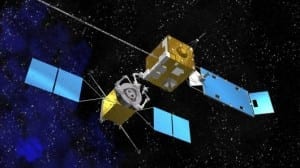
The space agency is developing a service robot that can visit ailing satellites and refuel or even repair them on the spot.
Geostationary satellites cost a fortune and, despite their sophistication, they break down or eventually run out of propellant to keep them oriented. This is unfortunate when the nearest garage is back on Earth, so NASA wants to remedy this with an orbital version of roadside service. The space agency is developing a service robot that can visit ailing satellites and refuel or even repair them on the spot.
Geosynchronous satellites are a vital part of the modern world. Orbiting 22,300 miles (35,800 km) above the earth, they are a key link in global telecommunications, and keep a constant eye on the planet’s weather. They are extremely valuable both for the work they do, and due to the cost of building them and putting them in orbit.
Unfortunately, their service life can be frustratingly short. Even if a satellite operates flawlessly for years without a component failing, there comes a day when it runs out of propellant and can no longer keep itself on station and properly pointed. When that happens, it goes from being a vital part of the global infrastructure to so much space junk. With 149 government-owned spacecraft and 275 commercial satellites currently in geosynchronous orbit, that is a very large investment at risk.
NASA’s Goddard Space Flight Center is working to develop orbital robots that can intercept, refuel and service geosynchronous satellites. The refueling program is already at an advanced enough stage that a technology demonstrator called the Robotic Refueling Mission (RRM) was delivered to the International Space Station (ISS) in July of last year. The RRM was installed on a temporary platform outside the station.
Though it’s designed to refuel satellites, the RRM isn’t just an outer space petrol pump. It’s more of a robotic mechanic with tools to manipulate wires, unscrew caps and operate valves. In March of this year the space station’s RRM, nicknamed “Dextre,” cut two twisted “lock wires” – each one measuring 20 thousandths of an inch (0.5 mm) in diameter. This was an extremely delicate operation and a first for a space robot.
The reason why the RRM needs these capabilities is that the service robot isn’t just intended to refuel satellites designed to receive it, but others as well. Goddard wants a robot capable of carrying out what it calls the five “Rs” – refueling, repositioning, remote survey, component replacement or repairing – on any satellite that might require its services.
via Gizmag – David Szondy
The Latest Streaming News: Satellite refueling robot updated minute-by-minute
Bookmark this page and come back often
Latest NEWS
Latest VIDEO







